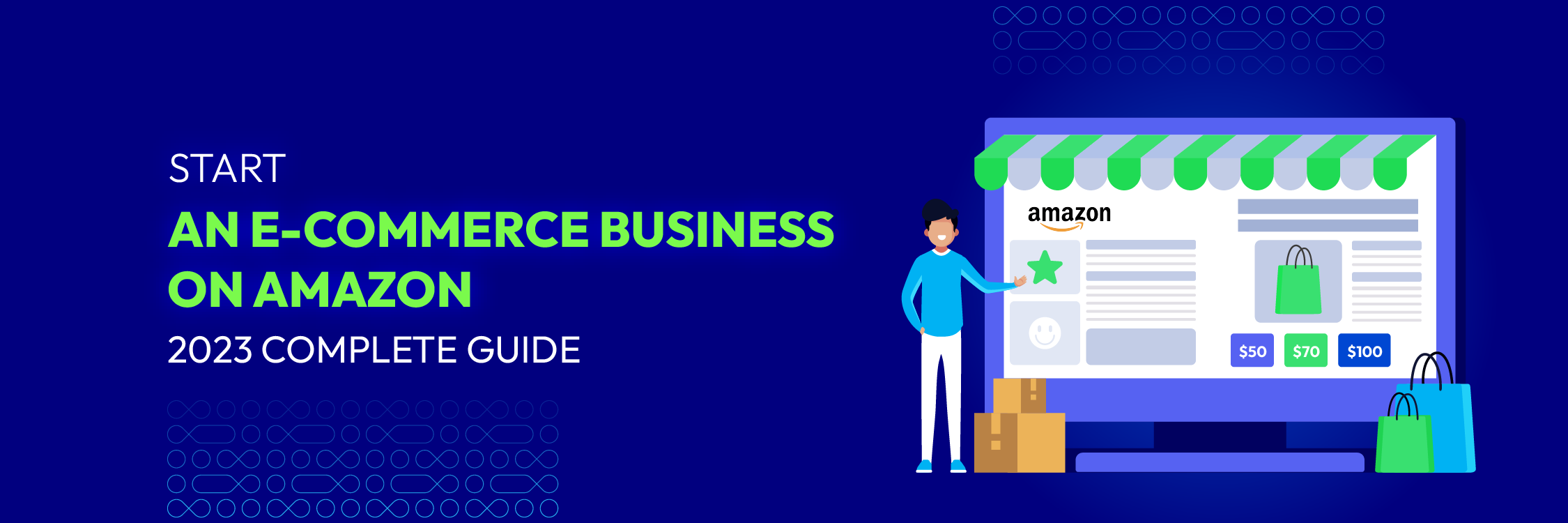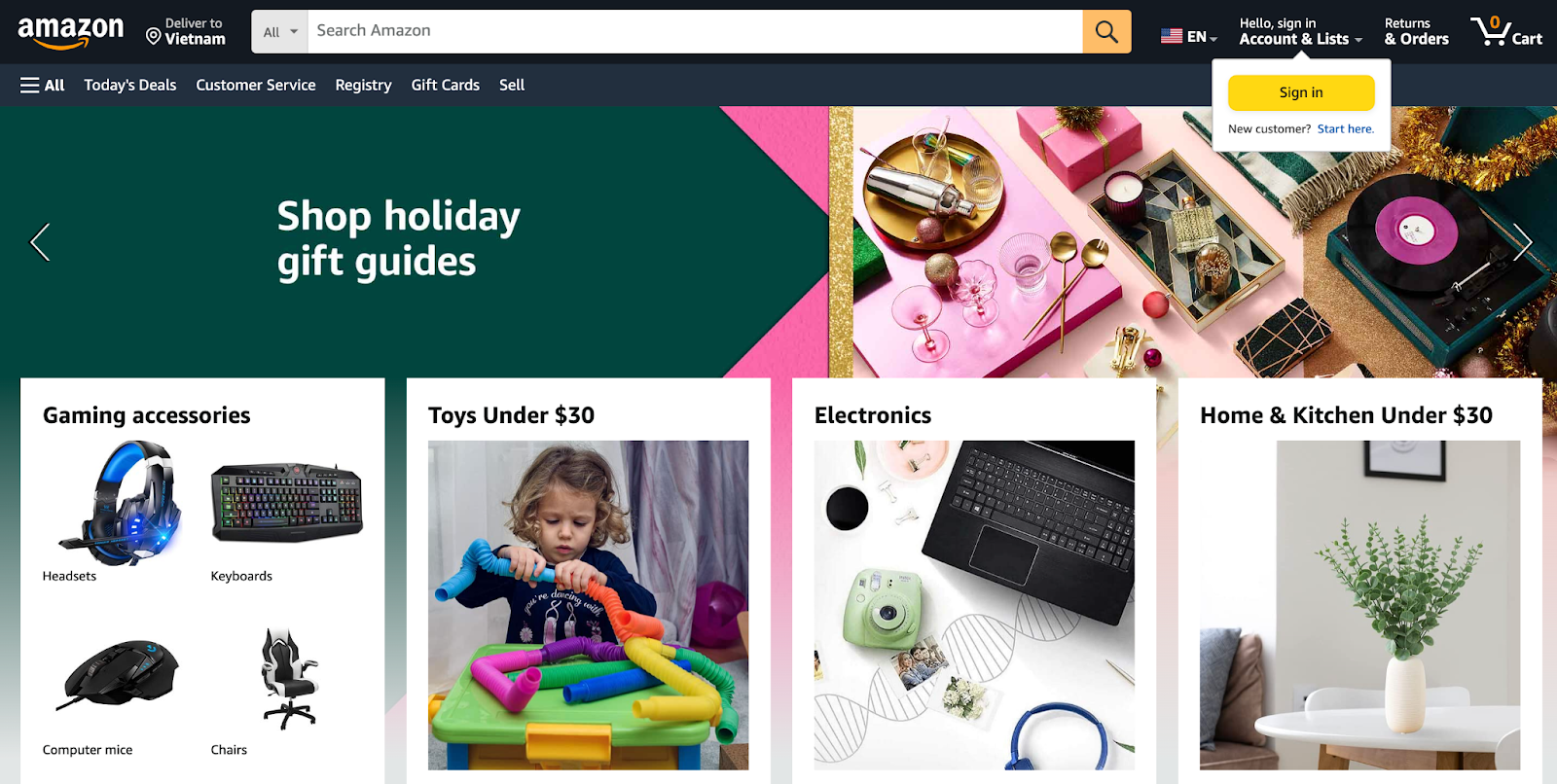Start an Ecommerce Business on Amazon: 2023 Complete Guide
Summer Nguyen | 11-09-2023


The Most Popular Extension Builder for Magento 2
With a big catalog of 224+ extensions for your online store
Amazon is the preferred platform for over 1.9 million sellers for a reason. It holds the top spot globally as the largest online retailer, with eBay coming in a distant second place.
Scoring high on the Customer Satisfaction Index, this retail giant boasts over 300 million customer accounts, providing valuable opportunities for small and mid-sized businesses to profit from online sales. Many sellers on the platform have achieved remarkable sales, surpassing the $100,000 and million-dollar milestones.
Interested in giving Amazon a try? This article will provide you with insights into the advantages of becoming a seller on the platform and guide you through the process of setting up your ecommerce business on Amazon.
Table of Contents
- Benefits of Selling on Amazon
- Decide How to Sell
- Step-by-Step Guide for Starting Your Amazon Business
- Grow Your Business With Your Own Website
- Conclusion
Benefits of Selling on Amazon

There’s a compelling rationale behind the growing trend of people venturing into ecommerce businesses. Amazon, in particular, stands out as an excellent starting point for the following reasons:
-
Robust Traffic: Amazon ranks among the most frequented destinations on the internet, attracting visitors with a clear intent to make purchases. If you’re entering the online selling arena, it makes sense to do so on the world’s largest online marketplace.
-
Turnkey Solution: Selling on Amazon, and online commerce in general, offers a significant advantage with minimal overhead costs. You can operate your ecommerce business Amazon without the need for a physical store, managing it comfortably from your own computer.
-
The FBA System: Amazon simplifies online selling through its Fulfillment by Amazon (FBA) system. This enables you to ship your inventory directly to Amazon, allowing them to handle aspects like storage, order processing, and shipping on your behalf. It’s the most hands-off ecommerce business Amazon model for selling on this platform.
-
Ongoing Enhancement and Innovation: Amazon holds the top spot in the online shopping domain for a reason; they consistently invest in staying ahead. Amazon continually strives to enhance the value they offer to customers and expand opportunities for growth among third-party sellers on their platform.
Decide How to Sell

This online platform offers sellers a high degree of flexibility in their product selling approaches. Here are five of the most popular ecommerce business Amazon models available, along with what they entail for you:
1. Dropshipping
In the dropshipping model, there’s no need to maintain an inventory or warehouse space. When an order is placed, you simply share the order details with the supplier, brand, or manufacturer, who then handles order fulfillment. Essentially, your role is limited to acquiring orders, while tasks like sourcing, shipping, and storage are outsourced.
2. Private Label
Opting for this model involves taking on more responsibilities, which include:
- Sourcing products from a supplier
- Collaborating with manufacturers or suppliers to customize products with your brand elements
While this approach may demand more effort, it’s worth noting that 80% of U.S. consumers show a preference for it, making the additional work potentially rewarding.
3. Online and/or Retail Arbitrage
This model necessitates purchasing products from physical retail stores or online websites. The idea is to find low-priced or discounted items in places like retail stores, big box retailers, and discount platforms such as eBay and Alibaba, which can then be resold on ecommerce business Amazon platform for a profit. Although it sounds straightforward, it requires a considerable amount of time before yielding results.
4. Wholesale
With the wholesale model, you can buy high-demand products in bulk from a brand or manufacturer at a low or deeply discounted price and subsequently sell them as individual units by listing them on the brand/manufacturer’s existing listings. This approach allows you to tap into established product demand and generate substantial profits.
5. Handmade
If you create your own products, the handmade selling method is an ideal fit for you. It permits the sale of your handmade items, be it jewelry or home decor, on the Amazon marketplace. This niche has a dedicated section on Amazon, which can enhance your visibility and increase your chances of making sales. A crucial tip: Evaluate your available capital and time to ensure that this system can yield profitable results for you.
All of these methods involve selling products on Amazon and conducting your own marketing efforts. The key distinction lies in the behind-the-scenes processes that occur once an order is received.
Step-by-Step Guide for Starting Your Amazon Business
Amazon simplifies the process of establishing an online store, and here are the general steps you should follow:

1. Product Research
Identifying the right product is often the most challenging aspect of ecommerce. It involves researching which products to sell, striking the right product mix, and conducting thorough market research. The most promising products are those in high demand but with limited competition.
You’ll also need to locate a reliable supplier offering profitable margins. For a more efficient approach, consider using the AMZScout OA and Dropshipping extension, which can help you discover profitable products while filtering out high-competition, low-margin ones and optimize your budget for business growth.
2. Seller Plan Selection
Your choice of a seller plan on Amazon influences the standard fees you’ll incur and provides insights into your expected sales volume. There are two options:
- Professional, allowing you to sell more than 40 products per month.
- Individual, suitable if you plan to sell fewer than 40 products monthly.
Keep in mind that the individual plan excludes eligibility for the Amazon Buy Box. This Buy Box is a coveted section where Amazon recommends products from various sellers based on customer preferences, a valuable spot usually reserved for trusted companies with significant sales volumes.
3. Choose a Fulfillment Model
Amazon offers two fulfillment models: FBA (Fulfilled by Amazon) and FBM (Fulfilled by Merchant). Both models offer distinct benefits, and your choice depends on your specific business needs.
FBM(Fulfilled by Merchant)
3PL for Amazon FBM involves handling all aspects of the sales process, including product listing, storage, shipping, and customer support. It offers more control, it can be more labour-intensive, and customer support costs may arise.
FBA(Fulfilled by Amazon)
FBA simplifies things by having Amazon manage fulfillment. This approach may even qualify you for Amazon Prime, ensuring quick product delivery. This is enticing for shoppers and can improve your chances of selling and receiving positive reviews. You can also explore a combination of both models for customized fulfillment solutions.
4. Understand Amazon Fees
As an online entrepreneur, it’s crucial to be aware of the costs associated with selling on Amazon. Key expenses to consider include:
- Fulfillment Fees: These fees are incurred for each order fulfilled by Amazon and vary based on product size and weight. Individual sellers pay a standard fulfillment fee of $0.99 per sale.
- Referral Fees: Amazon charges a commission for selling on its platform, typically ranging from 8% to 15%, varying by product category.
- Storage Fees: These are based on product size and weight, charged per square foot, with additional costs for prolonged storage.
- Other Fees: Additional expenses include shipping and handling costs, and for certain products like books or DVDs, media fees apply.
- For a comprehensive list of associated fees, you can refer to Amazon’s fee page.
5. Open a Seller Account
Once you’ve determined your product offerings and selected a seller plan for your ecommerce business Amazon, proceed to open a seller account. This involves providing essential information such as your business email address, location, business type, credit card details, government ID for identity verification, tax information, personal details, and a bank account for receiving proceeds from your sales. You’ll also need to specify details about the products you intend to sell.
6. Source the Product
After verifying your seller account, decide how you’ll source your inventory, which can be through methods like retail arbitrage, online arbitrage, dropshipping, wholesale, and more. Prior to making a choice:
- Seek out best-selling products with low competition.
- Compare product ideas to assess factors like demand, competition, profit margins, availability, regulations, and shipping costs.
- Contact potential suppliers, manufacturers, as well as online and brick-and-mortar stores to obtain samples, allowing you to assess product quality and understand the customer experience better.
7. List your Product

After finalizing your product selection, list your inventory on Amazon, which can be done by either piggybacking on an existing listing or creating a new one. Optimizing your product listing is vital for visibility and searchability.
This includes using the right keywords in your product title, employing bullet points for clear product descriptions, uploading high-quality images and videos, and conducting A/B testing to gauge customer preferences. After uploading this information, your listing should become visible on Amazon within an hour.
8. Promote Your Listings To Improve Sales
Once your Amazon storefront is set up, your work is far from over. You need to promote your products to attract customers and drive sales. This entails continuous adjustments to your marketing strategies and listings to enhance searchability, visibility, and conversions.
Promote your products on platforms like Instagram, Facebook, and Google to generate traffic and aim for first-page product placement. Interact with customers to build a positive brand image and consider collaborating with influencers to raise awareness of your products.

Increase visibility and reach for products on various marketing channels (Hyva ready)
Check it out!Grow Your Business With Your Own Website
Once you have honed your online selling skills and are experiencing robust sales, it might be a suitable moment to contemplate establishing your own website for selling your products of your ecommerce business Amazon.
Certainly, this is a significant step, but it presents an excellent opportunity to expand and create a distinct brand identity separate from Amazon.
When you are prepared to take this leap:
-
Concentrate on marketing a product you are truly passionate about. This will enable you to collaborate closely with your manufacturer and integrate your unique insights into the design process.
-
Officially register your business with the appropriate government authorities, ensuring that all legal requirements are thoroughly addressed.
-
Purchase a domain name and construct your website. Pay special attention to optimizing the content and enhancing the user experience.
-
Create captivating and user-friendly product pages, incorporating elements like videos, infographics, and pertinent product specifications.
-
Implement secure payment gateways and provide various payment options for your customers.
-
Arrange for essential customer service, logistics, and order fulfillment processes.
Lastly, launch your independent business venture.
Conclusion
During Amazon’s 2021 fiscal year, the retail giant captured 40% of all U.S. ecommerce sales. With its consistent growth and merchant-consumer convenience, it’s easy to see why Amazon remains the premier choice for online shopping.
Setting up an account and listing your products on ecommerce business Amazon is a straightforward process. The real challenge lies in effectively marketing your merchandise and ensuring it gains visibility to potential customers. Amazon offers user-friendly resources and support services, making it a top platform for both new online sellers and established businesses looking to expand their sales channels.



